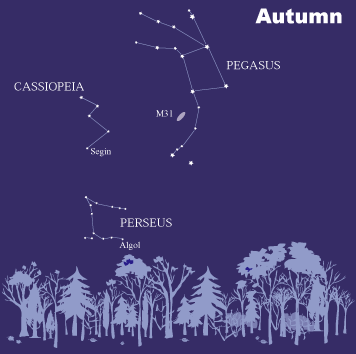These are some of the common constellations that can be seen at Cherry Springs State Park.
 Winter
Winter
One of the most well known constellations is Orion, (the Hunter) who travels across the sky from autumn through spring with his faithful dogs, Canis Major and Canis Minor, hunting celestial animals like Lepus the rabbit, and Taurus the bull. Shaped somewhat like an hourglass, Orion is composed of two stars at his shoulders, two stars at his knees, and three stars making his belt, from which hangs a sword. One of the objects in Orion’s sword is M42, the Great Orion Nebula, an area where stars are born. The slightly red star of Orion’s shoulder is Betelguese, a red giant star that is 630 times the size of the Sun and 60,000 times brighter.
 Spring
Spring
The most well known constellation in the northern skies is Ursa Major (the Great Bear). Most people know it for the asterism (unofficial constellation) within it, the Big Dipper. The middle star of the handle is actually a double star, Mizar and Alcor, which can be seen with the naked eye by people with good vision. The two stars on the outside edge of the pot of the dipper, Merak and Dubhe, are known as the Pointer Stars because they point to Polaris in the constellation Ursa Minor (the Little Bear). Most people know it for the asterism (unofficial constellation) within it, the Little Dipper. Often called the North Star, Polaris is the only star that does not appear to move across the sky. This is because the earth’s axis points toward the location of Polaris in space.
 Summer
Summer
The summer sky is dominated by the Summer Triangle, which is formed by the brightest stars of three constellations. The star Altair rotates 100 times faster than the sun and is in the constellation Aquila (the Eagle), which carries thunderbolts. An arrow creates the constellation Saggitta (the Arrow), which is just inside the triangle. The star Deneb is 160,000 times more luminous than the Sun, but since it is 2600 light years away, it appears only as a fairly bright star. Deneb is in the constellation Cygnus (the Swan), which flies along the Milky Way, looking for his friend, Phaeton. The star Vega is a mere 25 light years from the earth and is in the constellation Lyra (the Lyre), the musical instrument played by Orpheus, whose music was so sad that everyone wept.
 Autumn
Autumn
One of the most famous Greek myths is depicted in constellations that can be seen in the autumn and winter skies. Perseus, the hero, slew the medusa, creating the winged horse Pegasus. On his way home, Perseus slew Cetus, a sea monster that was about to eat Andromeda, whom he then married. The star Segin is 2500 times as luminous as the Sun and is in the constellation Cassiopeia the queen and mother of Andromeda. In the constellation Perseus, the star Algol drops in luminosity for several hours every 2.867 days, which is caused by a stellar eclipse. Called eclipsing double stars, Algol and a companion star rotate around each other every 2.876 days. When the dimmer companion passes between Algol and the Earth, it blocks part of the light from Algol. M31, the Great Galaxy in Andromeda, is visible to the eye, near the back legs of the constellation Pegasus.
Back to stargazing and astronomy